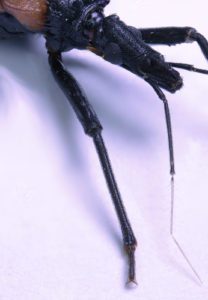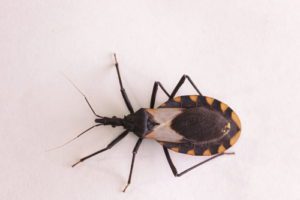DO I HAVE TO WORRY ABOUT BITES FROM KISSING BUGS?
By Chris Williams on May 8, 2019.
There’s been quite a bit of news lately about the unusual discovery of a triatomine “kissing bug” as far north in the U.S. as Delaware. It bit a girl’s face while she watched TV in her bedroom in an attempt to suck her blood. That’s what these bugs do, but they usually feed on wild or domestic animals, and they usually do it in the southern U.S. or in Latin America, not in the northern U.S.

Close up of Kissing Bug head. Shutterstock.
Kissing bugs have habits very similar to bed bugs. They hide during the day and suck blood from animals or sleeping people at night. While the immature kissing bug nymphs can be as small as a bed bug, the adult bugs are quite a bit larger, almost an inch long with orange or reddish markings. The several species that occur in the U.S. are also known as conenose bugs (because of their elongate head shape) or triatomine bugs (after the genus Triatoma).
WHY KISSING BUGS ARE A SPECIAL WORRY
Kissing bugs get people’s attention for several creepy reasons: (1) they suck blood from sleeping individuals, (2) they often bite people painlessly on the face and around the mouth, and (3) in rare cases, their feces can transmit Chagas disease if rubbed into the bite, a cut, eyes or mouth. Chagas is a mild parasitic disease for most but approximately 30% of people who get the disease are at risk of serious heart complications. Dogs are also affected by the disease.
Conenose bugs are not usually found in homes. In regions where they occur, they are more apt to be found in or near the nests of raccoons, opossums, squirrels, or pack rats in the West, and are associated with outbuildings like chicken coops, doghouses, outhouses, and barns. When found in homes, it is often because outdoor wildlife, livestock (chickens, etc.), or pets brought them into the house. For this reason, the bugs and Chagas disease are more common in rural or lower income regions where housing is substandard.
DO WE HAVE KISSING BUGS IN THE NORTHEAST, OR NOT?

Kissing Bug. Shutterstock.
The kissing bug has traditionally been a pest of Latin America and some southwestern states. If you drew a horizontal line pretty much across the middle of a map of the continental U.S., the 28 states below that line (plus Hawaii) are the states where kissing bugs have been reported. The species found in Delaware, Triatoma sanguisuga, has previously been known to occur in the east from Florida to as far north as Pennsylvania, and west to Kansas. Some say the ranges of kissing bug species are expanding but just how far north these southern bugs could go in North America and still tolerate winters remains to be seen.
While kissing bugs are not known to occur in New Hampshire or Massachusetts, there have been people diagnosed with Chagas disease in the Northeast. This is attributed to travelers returning from Central or South America or to immigrants from Chagas regions who have relocated. About 300,000 residents throughout the U.S. have Chagas, mostly contracted outside of the U.S. About 8 million people in Latin America are living with Chagas disease.
The Delaware girl bitten by the state’s first confirmed “kissing bug” did not suffer any ill effects.